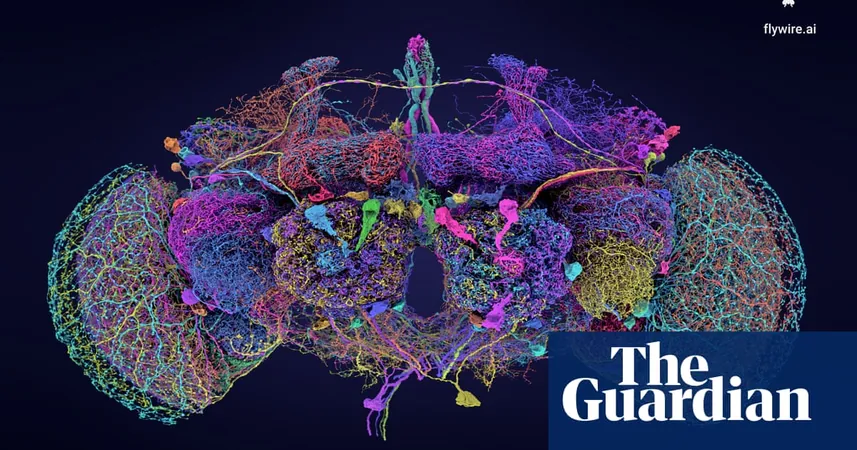
Tiny Brain, Huge Breakthrough: Fruit Fly Connectome Set to Revolutionize Neuroscience
2024-10-02
Author: Chun
Introduction
Researchers have achieved a groundbreaking milestone by constructing the first comprehensive wiring diagram of a fruit fly's brain, an endeavor that could fundamentally transform our understanding of neuroscience and how brains orchestrate behavior.
Mapping the Fly Brain
In an unprecedented scientific effort, a team dedicated years to meticulously mapping the complex network of 139,255 neurons and roughly 50 million synaptic connections housed within the fruit fly’s remarkably tiny brain—about the size of a poppy seed. This colossal feat involved categorizing over 8,400 distinct cell types, creating the most exhaustive blueprint for assembling a fly brain ever produced.
Significance of the Achievement
Sebastian Seung, a prominent professor of computer science and neuroscience at Princeton University and co-leader of the FlyWire project, commented on the significance of this achievement: 'You might be asking why we should care about the brain of a fruit fly. My simple answer is that understanding any brain functions can reveal insights into all brains.'
The Research Process
The ambitious project began with scientists slicing a female fruit fly’s brain into an astounding 7,000 thin sections, followed by meticulous imaging using electron microscopy to visualize structures as minuscule as four-millionths of a millimeter. Advanced artificial intelligence (AI) was then employed to assist in analyzing the millions of images and meticulously tracing the intricate pathways of neurons and synapses. However, the AI's initial errors required the cooperation of a global community of scientists and volunteers to refine the final wiring diagram.
Preliminary Findings
This monumental effort has already yielded promising results. Researchers utilized the wiring diagram, referred to as the connectome, to identify 'interrogator' neurons that appear to integrate various types of sensory information, and 'broadcaster' neurons that may relay signals across different neural circuits. Notably, they discovered a specific neural circuit responsible for causing fruit flies to halt momentarily while walking.
Computer Simulation and Future Research
Harnessing the connectome, scientists created a computer simulation of sections of the fruit fly brain, which revealed neural circuits associated with taste processing. This innovative approach suggests that future simulations may significantly enhance our understanding of how neural wiring influences animal behavior.
Implications of Connectomics
Seung emphasized the implications of this advancement, stating, 'Connectomics is the beginning of a digital transformation of neuroscience, and this transformation will extend to brain simulation. This is going to be a rapid acceleration in the field of neuroscience.'
Collaborative Effort
The collaborative project involved researchers from various countries, including Canada, Germany, and the MRC Laboratory of Molecular Biology at the University of Cambridge, with findings published across nine papers in the prestigious journal Nature. Notably, Dr. Anita Devineni, a neuroscientist at Emory University, hailed the wiring diagram as a 'landmark achievement.'
Future Mapping Projects
Excitingly, endeavors have already commenced to create a complete wiring diagram for the mouse brain, with researchers optimistic about completing this task within the next five to ten years. However, mapping the human brain, which contains approximately 86 billion neurons and trillions of synaptic connections, presents a far greater challenge. It is estimated that the complexity of the human brain is about a million times that of the fruit fly's, and the data storage required would be astronomical—around one zettabyte, which is equivalent to all of the world's internet traffic in a year.
Implications for Neurological Disorders
A more feasible approach may involve mapping the neuronal wiring in segments of the human brain, which could provide critical insights into whether improper wiring contributes to neuropsychiatric disorders and other brain-related conditions. Dr. John Ngai, director of the US National Institutes of Health’s Brain Initiative, emphasized the importance of these efforts by stating, 'We cannot fix what we do not understand, and this is why we believe this moment is profound.'
Conclusion
As we delve deeper into the enigmatic workings of the brain, this stunning fruit fly connectome serves as a springboard for future discoveries that hold the potential to reshape our understanding of neurobiology and potentially address the challenges of neurological disorders worldwide.


 Brasil (PT)
Brasil (PT)
 Canada (EN)
Canada (EN)
 Chile (ES)
Chile (ES)
 España (ES)
España (ES)
 France (FR)
France (FR)
 Hong Kong (EN)
Hong Kong (EN)
 Italia (IT)
Italia (IT)
 日本 (JA)
日本 (JA)
 Magyarország (HU)
Magyarország (HU)
 Norge (NO)
Norge (NO)
 Polska (PL)
Polska (PL)
 Schweiz (DE)
Schweiz (DE)
 Singapore (EN)
Singapore (EN)
 Sverige (SV)
Sverige (SV)
 Suomi (FI)
Suomi (FI)
 Türkiye (TR)
Türkiye (TR)